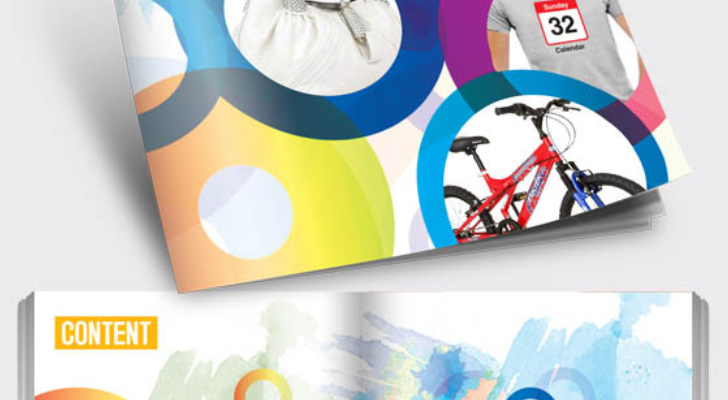Catalog Designing

A catalog is a powerful marketing tool that visually communicates a brand's products or services, providing potential customers with a comprehensive and engaging overview. The design of a catalog plays a crucial role in capturing attention, guiding the reader through the content, and encouraging them to take action. Let's explore key principles and tips for creating an effective and visually appealing catalog design.
1. Clearly Define Objectives: Before diving into design, clearly define the objectives of your catalog. Are you showcasing a product line, promoting seasonal offers, or presenting a range of services? Understanding the purpose guides the design and content strategy.
2. Understand Your Audience: Identify your target audience and tailor the catalog to their preferences and expectations. Consider factors like age, interests, and demographics when selecting design elements and visual styles.
3. Organize Content Strategically: Establish a logical content hierarchy to guide the reader seamlessly through the catalog. Group related products or services, and use consistent headings, subheadings, and call-to-action elements for clarity.
4. High-Quality Visuals: Invest in high-resolution images that showcase your products or services in the best light. Clear and compelling visuals capture attention and convey the quality and uniqueness of what you offer.
5. Consistent Branding: Maintain consistency in branding elements, including logo placement, color schemes, and typography. A cohesive design reinforces brand identity and builds trust with the audience.
6. Typography and Readability: Choose legible fonts and maintain a good balance between font sizes for headings and body text. Ensure that the text is easy to read, especially when describing product details or features.
7. White Space for Clarity: Allow sufficient white space to prevent visual clutter. White space enhances readability, directs attention, and contributes to an overall clean and sophisticated design.
8. Product Details and Descriptions: Include comprehensive product details and descriptions. Highlight key features, benefits, and pricing information to provide readers with the information they need to make informed decisions.
9. Call-to-Action Elements: Strategically place call-to-action elements throughout the catalog. Encourage readers to visit your website, make a purchase, or contact your business. Make these elements visually distinct for emphasis.
10. Seasonal or Theme Integration: Consider integrating seasonal or thematic elements to add visual interest. This could include seasonal color schemes, holiday-themed sections, or thematic groupings of products.
11. Grid Layouts for Consistency: Use a grid layout to maintain consistency in the arrangement of images and text. Consistent spacing and alignment contribute to a professional and polished look.
12. Testimonials and Reviews: If applicable, feature customer testimonials or reviews. Social proof adds credibility to your offerings and can influence the purchasing decisions of potential customers.
13. Print-Friendly Considerations: If your catalog will be printed, ensure that the design is print-friendly. Use high-resolution images, select appropriate color profiles, and set document dimensions with proper bleed and margin settings.
Example of a Catalog Design for a Fashion Brand:
Cover: A visually striking image featuring a model wearing a signature outfit with the brand logo discreetly placed. Inside, sections organized by clothing categories, each showcasing products with detailed descriptions, prices, and call-to-action details.
This example combines a visually appealing cover, organized content structure, and consistent branding for a compelling catalog design in the fashion industry.
🚀 Master Top Web & App Frameworks
Explore structured tutorials for AngularJS, React, Laravel, Flutter, PHP, SQL, and more.
📘 Introduction to AngularJS
Introduction to AngularJS overview
📘 Introduction to Laravel
Learn Introduction to Laravel in Laravel with real-world examples and step-by-step guide.
📘 Introduction to CodeIgniter
An introduction to Introduction to CodeIgniter in CodeIgniter with examples.
📘 Introduction to React
Quick overview and guide to Introduction to React in React JS.
📘 Introduction to Flutter
An easy-to-follow tutorial on Introduction to Flutter in Flutter mobile app development.
📘 Introduction to Kotlin
Learn Introduction to Kotlin in Kotlin programming with examples for Android or backend apps.
📘 Introduction to PHP
Understand Introduction to PHP in PHP with practical examples and clear syntax.
📘 Introduction to SQL
Understand Introduction to SQL in SQL for effective database querying and management.
📘 Introduction to Bootstrap 5
Understand Introduction to Bootstrap 5 in Bootstrap 5 for responsive web design using pre-built components.
📘 Introduction to HTML
Understand Introduction to HTML in HTML to create structured, semantic, and accessible web content.
📘 Introduction to CSS
Explore Introduction to CSS in CSS to enhance web design using styling properties and layout techniques.
📘 Introduction to JavaScript
Understand Introduction to JavaScript in JavaScript to build dynamic and interactive web experiences.
📘 Introduction to Node.js
Explore Introduction to Node.js in NodeJS for backend development using JavaScript and non-blocking architecture.
📘 Introduction to AJAX
Understand Introduction to AJAX in AJAX to update web pages without full reloads using asynchronous JavaScript and XML.
📘 Introduction to jQuery
Learn Introduction to jQuery in jQuery to write less and do more with simplified JavaScript operations and cross-brow...
📰 Latest Blog Posts
Insights, tutorials, and tech stories from our experts.
Transform Your Passion into a Web Development Career
Do you love tech? Let’s turn it into a profession with full stack development.
Not Just Coding – Career-Focused Full Stack Training
We don’t just teach code—we teach how to get jobs with it.
Learn, Code, Build, Get Hired – Full Stack Program
A step-by-step path to go from beginner to hired developer.
BCA/MCA/B.Tech? Start Building Real Websites Now!
Already pursuing IT education? Now build real websites with us!
Offline Full Stack Training in Dwarka & Uttam Nagar – Limited Seats!
Join our offline batch in Dwarka or Uttam Nagar and learn full stack development practically.
Struggling in Interviews? Build Skills That Get You Hired!
Facing rejections in job interviews? Build the right skills and project experience.


